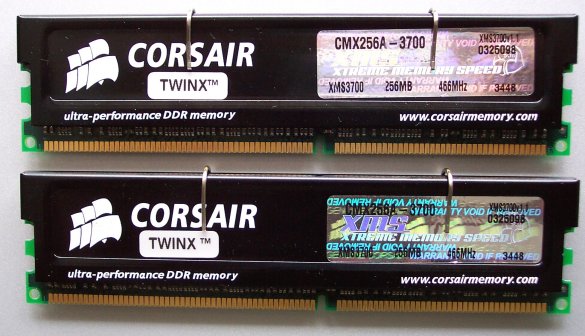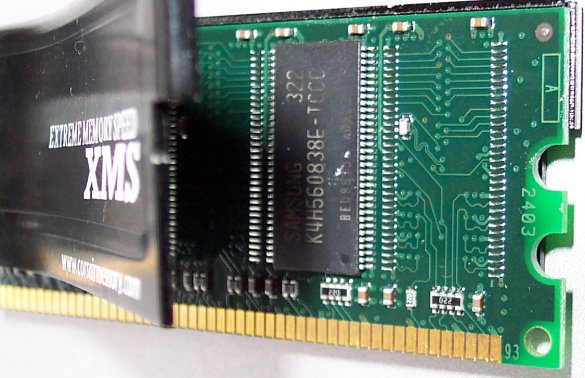Examination and specs.
Corsair has revised its method of delivery. That's just a fancy-pants method of stating that the general packaging has changed. Corsair used to bundle XMS memory in individual plastic containers.

A 512MByte TwinX Matched Memory Pair. That, in plain English, means that these two modules have been pre-tested together to work at DDR466 speeds. Testing, as we understand it, was undertaken on an ASUS P4C800 Canterwood motherboard and modules that are able to run at the stated speeds are packaged together to form a TwinX matched memory kit.

A closer look at the partners in crime. Note that the serial numbers are identical on both. The flashy holographic stickers spell out most of the important details. The 3448 numbers on the right-hand side are hugely important. These spell out the rated latencies of both parts. In general terms, the higher the latency, the lower the performance, assuming that overall frequency is consistent. We'll put this assertion to the test in the benchmarking section.
Corsair had used a number of speed-binned Winbond chips on its faster XMS series of RAM. The last speed champion, the Corsair XMS3500 C2, used Winbond B chips to great effect. Rumour had it that these modules made do with chips from a different manufacturer. There was only one way to find out. Removing the heatspreader is a little trickier than it might first appear. It's firmly attached via blocks of thermal tape. Careful prising revealed all:

These XMS3700 TwinX modules use none other than Samsung modules. The full code being K4H560838E-TCCC v322. A little further digging revealed that this is standard Samsung 512MB modules with a native rating of DDR400 @ 2.6v @ 3-3-3 timings. A pdf can be found here. Of course, we expect Corsair to use only the finest PCBs and routing, yet we cannot get away from the fact that these are not true PC3700 chips (4.3ns). Does it really matter ?. If the modules are able to do exactly what they're specified to then our gut feeling is that it doesn't. OCZ are (in)famous for running lower rated RAM at higher speeds without a problem and Corsair's own XMS3500 C2 is technically overclocked Winbond 5ns chips. You'll note that there are 4 chips on either side, making it single-sided RAM, technically speaking.
Official specifications
-
512MB and 1024MB kits available
-
Implemented using 32M x 8 DDR SDRAMs with Samsung 5ns chips (512MB kit)
-
100% tested at 233MHz (DDR466), as a pair, on an ASUS Canterwood motherboard
-
Integrated aluminium heat spreader for improved thermal performance
-
Lifetime Corsair warranty
-
Six-layer construction
-
Plug-n-Frag Auto-Configuration
-
Latency: 3-8-4-4-1T @ 2.65v ?
What's the defining factor for DDR performance. Is it more to do with pure MHZ speed or is it heavily influenced by latencies. Corsair offer up latencies in the name of pure speed. We'll now find out if they've approached DDR466 speeds with the right combination. On to the testing.









